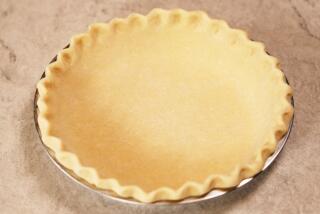Shortcuts to Pizza Crust at Home
- Share via
Question: I enjoy making pizza, except for the crust. Can you suggest any alternatives to making the dough from scratch?
Answer: We can think of several. Many Italian delicatessens and markets sell refrigerated pizza dough that’s ready to be spread onto the pan. Pizza parlors might also be willing to sell you prepared dough. Some other alternatives, available at many supermarkets, include refrigerated pizza crusts, frozen bread dough and Boboli bread.
Q: I cannot find Grandma’s Molasses BBQ Sauce. Can you tell me any Southern California stores that carry it?
A: Sorry, but the distributor tells us this product has been discontinued on the West Coast.
Q: Where can I buy dried lotus leaves? They come in great large sheets so one can wrap rice and vegetables in them for steaming.
A: “These large leaves, measuring 11 to 14 inches in diameter, are available in Asian markets”, said Diana and Paul Von Welanetz in “The Von Welanetz Guide to Ethnic Ingredients” (Warner Books: 1987, $10.95). “They are used fresh to add both flavor and fragrance to food, and dried to wrap foods such as glutinous rice to create a Tamale-like dish to serve as dim sum.”
The authors go on to say the leaves, tightly wrapped, will keep indefinitely in a cool, dry place. They can also be frozen. To prepare and use the leaves, “soak overnight or for a least 1 hour in warm water until soft. Use as a wrapping for Beggar’s Chicken or various rice stuffings. They are often used to wrap fish or pork that is to be steamed.”
Q: How do you calculate the amount of artificial sweetener to substitute for sugar in a cake recipe?
A: We can’t give you an answer because the two ingredients are not interchangeable. Their chemical properties differ, a factor that is especially critical in baking.
Those interested in preparing recipes using artificial sweeteners may obtain recipe booklets from many of the companies that produce these products. Check packages for ordering information.
Q: I’ve heard there is a hot line for questions about meat. Can you tell me the number?
A: You may reach the United States Department of Agriculture Meat and Poultry Hotline at (800) 535-4555. Staffed by home economists, the hot line operates weekdays from 10 a.m. to 4 p.m., EST.
Their experts can answer questions on the proper handling of meat and poultry, how to tell if it’s safe to eat and how to better understand meat and poultry labels. They can also explain how to handle problems with meat and poultry products.
Q: What’s the difference between Hachiyas and Fuyus persimmons?
A: The major difference between the two commercial varieties is “Pointy Hachiyas (accounting for 90 % of the U.S. commercial crop) should be ripened until squishy-soft before eating, while flat, tomato-shaped Fuyus can be enjoyed crisp, like apples,” according to “Fresh Produce A to Z” (Lane Publishing: 1987, $6.95).”
The editors of Sunset magazine and books also explain that although both varieties are bright orange in color and Asian in origin, skin color is not an indication of ripeness, since persimmons turn bright orange before they are mature. They recommend ripening persimmons at room temperature in a loosely closed bag to the appropriate stage for their variety, turning the fruit occasionally as it ripens. Then refrigerate the ripe fruit, unwashed, in a plastic bag.
Address questions on food preparation to You Asked About . . ., Food Section, The Times, Times Mirror Square, Los Angeles 90053. Personal replies cannot be given.
More to Read
Eat your way across L.A.
Get our weekly Tasting Notes newsletter for reviews, news and more.
You may occasionally receive promotional content from the Los Angeles Times.










